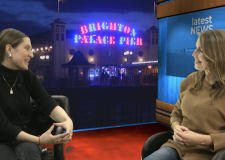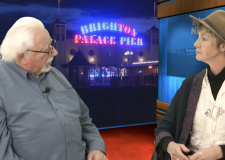News: The Vote
Where will our children live? And what about the poor? Housing chairman Bill Randall is in a hurry for answers
Ask Brighton and Hove’s politicians to name the most pressing problem facing the city and many will say housing. Rising prices – whether buying or renting – make it increasingly hard for people who grow up here to stay here when the time comes to fly the family nest.
Bill Randall, the former leader of Brighton and Hove City Council, is determined to do something about it – and he’s a man in a hurry. He plans to retire at the local elections next May which gives him less than six months as chairman of the council’s Housing Committee to secure a legacy.
Several schemes are in the pipeline as the council becomes one of only a few in England to resume building. But it’s a slow process. A year ago the first residents moved into Balchin Court, in Wellington Road, Brighton. The 15 properties were the first to have been built by the council in a generation.
But the scheme was devised by the Conservatives when they ran the council. They left office in May 2011.
Councillor Randall, a Green, has always credited the Tories with getting the ball rolling while pointing out that the job was completed on his watch.
But it added just 15 homes to the council’s stock of more than 11,000 houses and flats. And in the past two years alone, he said, 107 tenants had exercised their right to buy.
What’s more important: a room with a view or a room?
Now it’s Councillor Randall’s turn to get the ball rolling. His successor – of whatever political stripe – will, he hopes, inherit projects and momentum. Despite a difficult financial landscape, the council is due to start on more than 200 homes over the next few years.
At the last election the Greens hoped to make a start on a thousand “affordable” homes.
The aim was for housing associations to build most of them. But the financial rules changed, making it harder for the likes of Hyde, Affinity Sutton and Southern to fund schemes. And private developers baulked at the council’s policy of 40% social housing in every project to build more than ten homes.
Despite this, more than 600 affordable homes have been built. To the dismay of many and the anger of some, just under half have been for rent. Even housing associations are tending to build homes to sell or for shared ownership. More than once Councillor Randall has asked: “Who will house the poor?”
With the universities growing – more than 33,000 students already live in Brighton and Hove – he might also ask where will we house the poor? Not least because people priced out of London are also moving in. And after Chichester, Brighton is the most popular town or city for Londoners to buy a second home.
The council is struggling to identify enough land to satisfy a government planning inspector that it is allocating enough space for new homes. She urged officials to look at the “urban fringe” – green spaces mostly on the edge of the Downs.
Residents in Saltdean and Ovingdean have already voiced their opposition to building homes on greenfield sites. The prospect of 380 houses in Benfield Valley has also prompted concern. Toad’s Hole Valley in Hangleton appears to have proved more acceptable.
Councillor Randall said: “We don’t want to build on all of the fringe or on any allotments or parks but some sites – in addition to Toad’s Hole valley – are suitable. We should use some of it and we should use it sensitively. There’s a whole lot of nimby-ism going on at the moment. My question for them is this – what’s more important: a room with a view or a room? Where are our sons and daughters going to live?
“It’s important to the economy as well as people’s wellbeing. Companies wanting to move to the city ask is there space for me to base my company here and is there somewhere affordable for my staff to live. We could lose business to other areas because of it. It’s the most critical problem facing the city.”




















